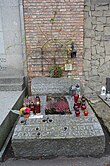Maria Grzegorzewska
She continued her education at the Jagiellonian University in Kraków and in 1913 joined her countrywoman, Józefa Joteyko in Brussels to study at the International Paedological Faculty.
After the establishment of the Second Polish Republic in 1918, Grzegorzewska returned to Poland intent upon creating programs which addressed the needs of disabled children and introducing educational reforms to improve their lives.
Using her own methodology, she designed curriculum which in 1922 was implemented at the newly founded State Institute of Special Education [pl] (Polish: Państwowy Instytut Pedagogiki Specjalnej).
Maria Stefania Grzegorzewska was born on 18 April 1887 in Wołucza, a village in the Kingdom of Poland of the Russian Empire to Felicja (née Bogdanowicz) and Adolf Grzegorzewski.
Her father served as the estate administrator and also oversaw neighboring farms, advocating for modernization of agricultural practices and humane treatment of workers.
[4] The youngest of six siblings,[2][5] including Zenon, Wanda, Helena, Witold and Władysław,[6] Grzegorzewska was influenced by her parents' sense of duty to their community.
[8] In 1900, when Grzegorzewska began her education in Poland, Russification programs caused many parents to send their children to clandestine private schools so that they could study Polish culture and language.
[10][12] Participating in the socialist youth underground and providing education for workers brought her to the attention of the tsarist police, forcing Grzegorzewska to flee to Lithuania.
Taking courses in pedagogy, psychology, and sociology, she began to meet eminent scholars and scientists, like Édouard Claparède, Émile Jaques-Dalcroze, and Ovide Decroly, among others, who influenced her development.
[2] Though the faculty of the school was a mix of international scientists, she shared lodging with Polish students Józefa Berggruen, Stefania Chmielakówna and Wanda Wosińska.
[19][20] While she was working on her dissertation, Grzegorzewska took part in a field trip to the Bicêtre Hospital, a psychiatric facility which treated people with severe intellectual disabilities.
Grzegorzewska wrote an article for the League, On the Need to Organize Special Education for Abnormal Children in Poland (Polish: O konieczności zorganizowania specjalnego szkolnictwa dla dzieci anormalnych w Polsce).
[25][28] Though at the time in Poland, there were limited facilities which had been established for deaf, blind, and intellectually disabled people, there was no national system to address the education of those living with physical or mental impairments.
Grzegorzewska aimed to implement educational methods she designed, mandatory training for teachers, and on-going research projects to assess the system over time.
[30] It approached evaluating chronically ill, disabled, or socially maladjusted children from an interdisciplinary, scientific stance, rather than focusing on their perceived defects.
[31][32] After a three-year period, in which she reorganized her teaching course several times, Grzegorzewska founded the State Institute of Special Education [pl] (Polish: Państwowy Instytut Pedagogiki Specjalnej) in 1922.
[25] In 1924, she founded the journal, Special School (Polish: Szkoła specjalna) to publish about the field and spur scientific work to develop "innovative methods of revalidation" for maladjusted and disabled children, which she directed to the end of her life.
[32] With the onset of World War II in 1939, the Special Education Institute was closed, and Grzegorzewska began working as a nurse in an army hospital run by the Polish Red Cross.
[42] Creating a detailed classification system, she advocated that the spectrum of disabilities was extremely broad and required teachers to individualize training to meet students' needs.
[45] Other letters gave historic information on innovators in education, and still others discussed humanitarian and ethical values as the keys to self-knowledge and coping mechanisms for change, which could in turn motivate and inspire others.
[50] She fought to protect special education and people with disabilities to prevent them from being harmed by production quotas and policies based on fear and suspicion.
[50] When the 1956 thaw granted the Polish government greater autonomy from Russian policies, she regained the support of authorities and the name of the Institute was reestablished.


